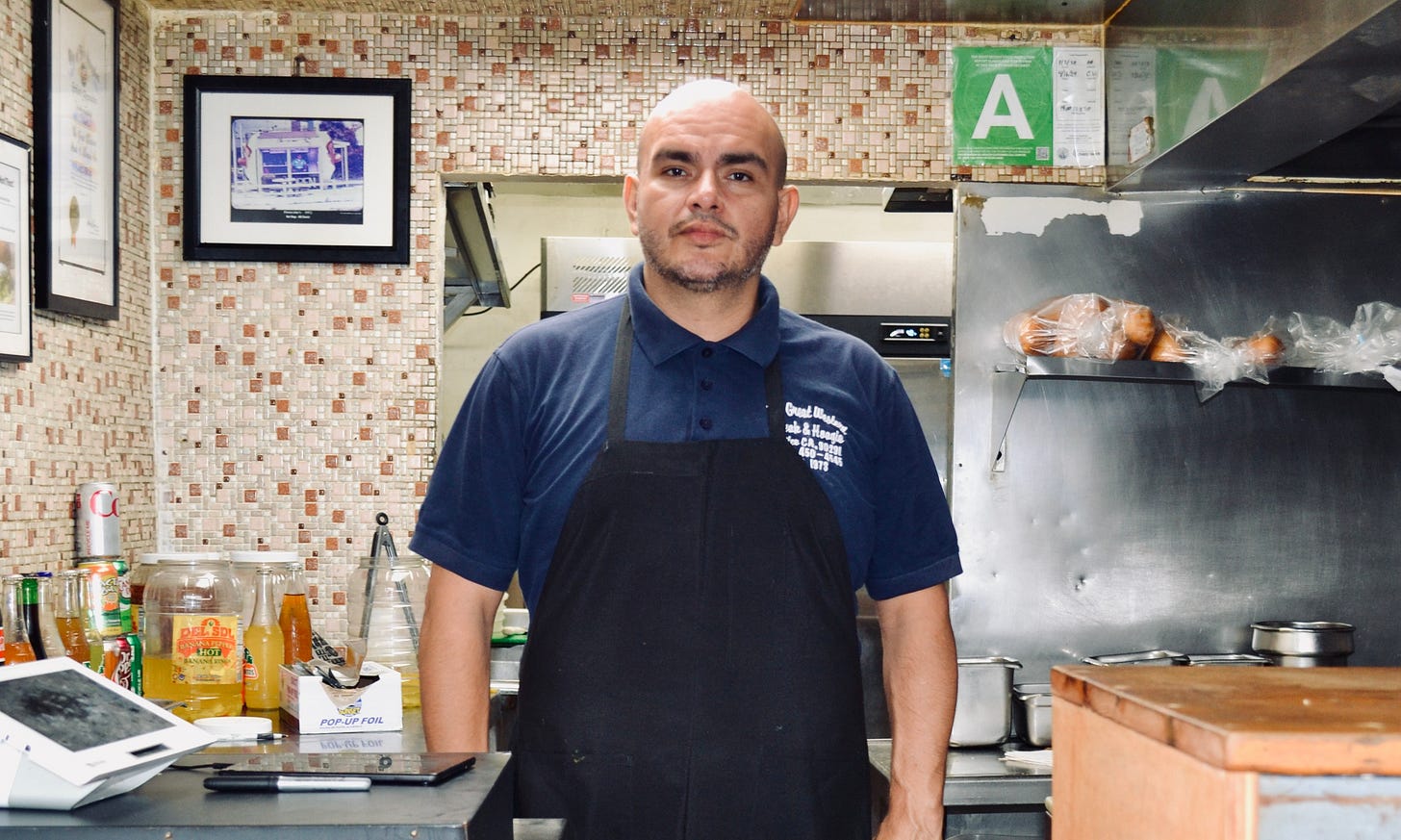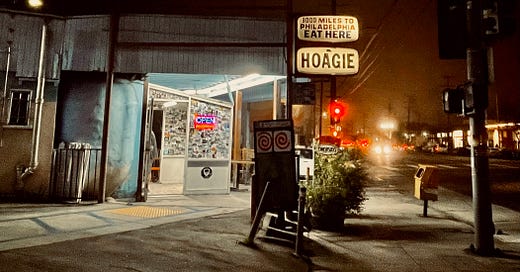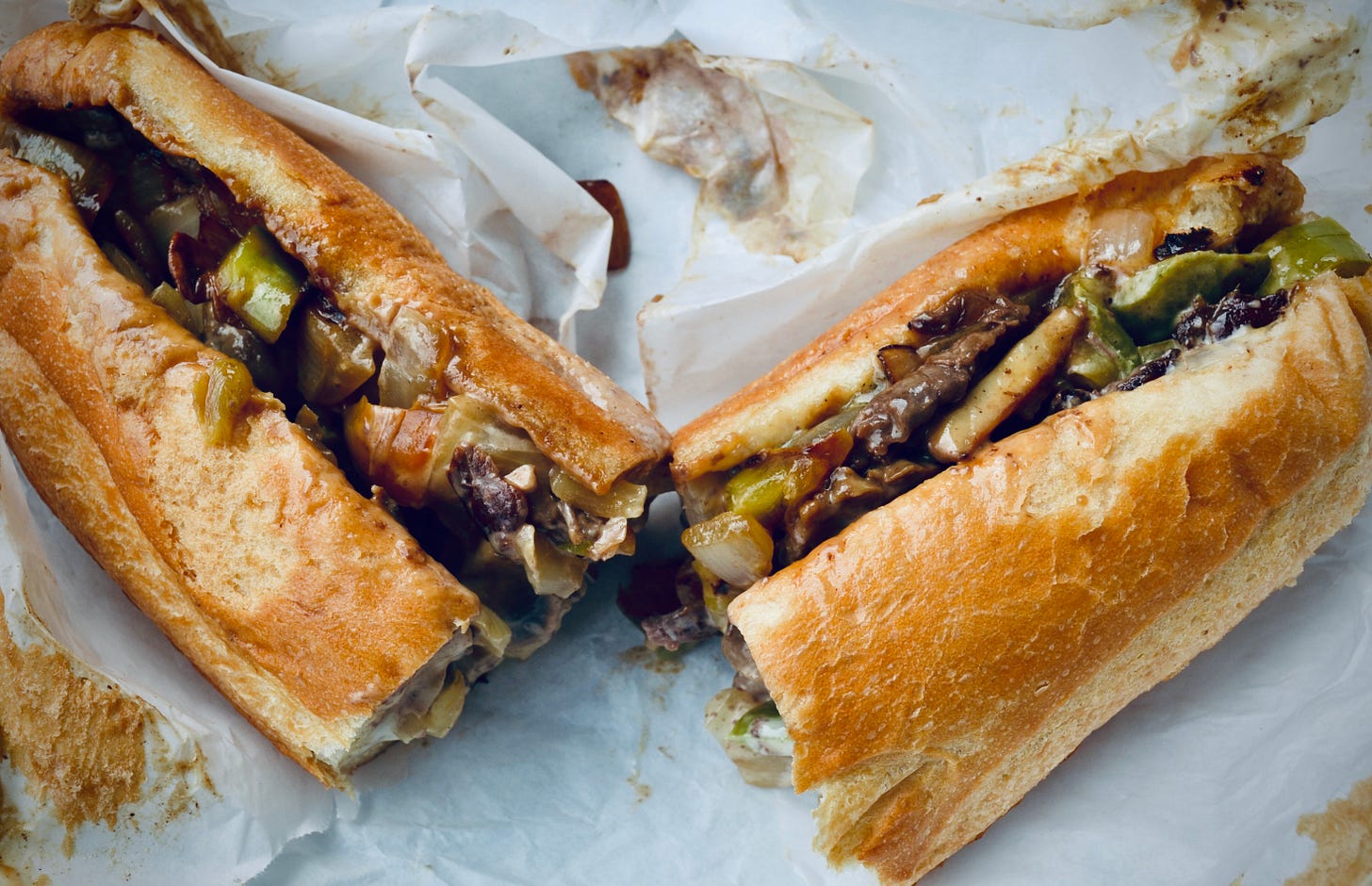Review: Great Western Steak & Hoagie Co
A Venice Beach institution proudly run by 0 people from Philadelphia
FOOD REVIEW: Great Western Steak and Hoagie Co. | 1720 Lincoln Blvd. Venice, CA 90291
If I were writing a food review of Great Western Steak and Hoagie Co. in Venice, I’d probably start by asking Sergio Perez, the fourth-generation owner, about Amoroso rolls and Philadelphia roots.
But Sergio isn’t from Philadelphia, nor was his father, nor was the Korean immigrant family that owned the restaurant before them. And they don’t source Amoroso rolls, Dietz and Watson meats, or any other signifier of Philly authenticity.
Yet for 51 years, Great Western has stood toe to toe with some of the city’s most well-capitalized commercial and real estate interests, fending off the pandemic and gentrification with nothing more than a $14 sandwich and the unshakeable loyalty of its community. No fries, no salad, no fountain drinks, no dessert, no advertising - just chips, soda and whatever comes off of the flattop.
As far as I and Sergio know, they’ve never been reviewed by a large publication. I can understand why a food critic might have trouble pitching a Venice Beach Philly cheesesteak restaurant run by 0 Philadelphians, selling 8 and half ounces of Vernon-sourced ribeye beef on a regular french roll from a local baker. As delicious as it is, the success of a sliced steak sandwich with grilled onions and cheese is not some grand mystery to unravel.
But in my personal atlas of Los Angeles, Great Western Steak & Hoagie Co. is one of the seven wonders of the city. It’s a Philly cheesesteak restaurant that’s actually the most locally beloved spot you can find in Venice. It’d be hard to find a place in the neighborhood that connects you to history and place more vividly. It has attracted a clientele that deeply values authenticity and roots but couldn’t care less about the cheesesteak’s origin story.
As one regular customer told Sergio, “Fuck Philadelphia. They got nothing to do with us over here. Why the fuck you gonna bring them into this? If you like it, you'd like it. If you don't get the fuck out of here.”
Great Western’s cheesesteak is a sandwich in which the bun exactly eclipses the filling. The ratio of ingredients to bread are balanced such that the bun doesn’t get soaked through and each bite is evenly portioned. The sandwich is double wrapped, sliced and sealed directly after the grill it retains heat and steams the bread slowly inside, which softens the bun without making it soggy, which helps the sandwich give way more easily to a bite. The sandwich, when hot, is too wobbly to be eaten with one hand, and will drip if tilted carelessly. Sergio says it’s best to let it breathe a little after unwrapping.
The onions are chopped coarsely rather than sliced thin and lacy, which emphasizes the texture. Chopped green bell peppers and mushrooms provide a helpful vegetal balance to all of the fat and protein.
On the side you can get two kinds of pickled chilis, diced jalapeno and whole yellow cherry. For condiments you can choose white American, provolone or mozzarella, with the option to add a homemade pizza sauce, which ends up tasting somewhere between a salsa and an Italian gravy.
The Great Western Hoagie and Steak Co. was built as one of the original locations of Tail O’ the Pup, a hot dog stand famous for being shaped like a hot dog. But the hot dog franchise never materialized. In 1973, George McMaster, who was indeed from Philadelphia, opened Great Western there along with a dozen other hoagie places across Los Angeles under different names.
Great Western is the lone survivor of both food chains, a tiny stand with an outdoor patio in a parking lot with five spaces. The glass windows on either side are thickly carpeted with stickers from multiple generations of taggers, brands and crews. The curves of the giant hot dog bun built into the original stand still protrude on either side, painted over with an image of a blue sky, fluffy clouds and palm trees.
Sergio said they recently updated their menu design, but when diners found out the new version left off the numbers assigned to the sandwich combos, they complained. He wrote them back up there in Sharpie. But because the order of the sandwiches no longer corresponds to the numbers, the effect is of a mysterious code that only makes sense to longtime customers.
Sergio sometimes feels like he’s stuck in an impossible balancing act between keeping everything the same and adjusting to constant change. He’s a friendly guy who will smile and entertain your questions about Philadelphia roots and Amoroso rolls and laugh at your takes about sandwiches in LA. He’s eaten all around Philadelphia and New Jersey and can talk cheesesteaks with the best of them - his favorite is Dalessandro’s. But it’s as if he finds a poet inside of himself when he talks about Great Western and its roots. He’s worked there all his life and it’s all he’s ever known.

I asked him what he wanted people to appreciate more about the restaurant: “the echoes of the laughter from all the people who came here and the relationships they made.”
On expanding beyond a single storefront: “My father, he feels so lucky to have the restaurant that he’s scared. I don’t know what that’s like, to feel so lucky you’re always worried luck will run out.”
When he was growing up, Great Western was the neutral ground between the Venice 13’s and the Shoreline Crips. If you got into trouble outside of your neighborhood, you could “run to hoagie” and be safe, Sergio said. Sex workers walked Lincoln Boulevard in droves back then and “hoagie” was their break room and cafeteria. The restaurant became a haven for a lot of people who didn’t have anywhere else to go, Sergio said.
But that also meant the payphone in front of the restaurant became the main office line for a lot of drug dealers, which attracted the attention of the police. First officers threatened to shut them down under the assumption they were running the whole criminal operation. Then, having proved their innocence, the Perez family watched as undercover police ran prostitution sting operations in the parking lot. He remembers that even as an 8 year old, he found the whole thing ridiculous.
The neighborhood has changed so much and so often that Sergio seems exhausted thinking about all the ups and downs.
“To see your whole neighborhood…it’s just not even the reflection of what a glimpse of what it was,” he said. “It’s hard not knowing where we’re going to end up a year from now, especially since we’ve lost so much this year.”
I ask what losses he’s talking about.
“Spanto,” he said.
Chris “Spanto” Printup was everything to Sergio, he said, “his safety net,” a comforting, stable presence in his life that made him feel like things would work out. The two met in the second grade and became fast friends. After Spanto died in a car accident in June last year, people kept coming by the restaurant to visit Sergio and pay their respects.
Spanto is a big reason why he wants to keep the restaurant going, Sergio said. As young men, they used to climb up and sit on the roof of the restaurant, passing a bottle and smoking, speaking their dreams out aloud. First they would franchise Great Western, across California first but after that the whole world. They dreamed up t-shirts and clothing lines and brands and other ways to make their names and their neighborhood ring out.
When Spanto died, “it took everybody’s hope. It took everyone’s dreams and aspirations with it,” Sergio said. Just flipped them off like a light switch. It took him a long time to find a new reason to keep going. Eventually he understood that Spanto wouldn’t have wanted him to waste time mourning something that would never come back. And now that Spanto was gone, it was especially important to try to make their boyhood dreams real.
Those dreams are what convinced Sergio to get sober in January. They’re what inspired discussions between he and his brother about expanding and franchising. They’re what fuel this restaurant and what make this sandwich special.
I don’t know if a Philadelphian would eat this sandwich and taste home, probably not. But for generations of Venetians, that’s exactly what Great Western has meant.
If you eat there, try to forget about the Amoroso rolls. Think of Sergio and Spanto sitting up on top of the Great Western sign. Not just them but all the daring dreams of local kids ignored by the cities that raised them; of friendships so powerful and propulsive they feel like rocket ships; of the bravery that everyone experiencing pain and loss finds in the search for a reason to keep going.
Think of the sandwich, too. It’s really good. You should try it.
Update note: The first version of this story incorrectly stated the price of the sandwich, the type of peppers and cheese available on the sandwich. I’ve updated the story with the correct descriptions.






